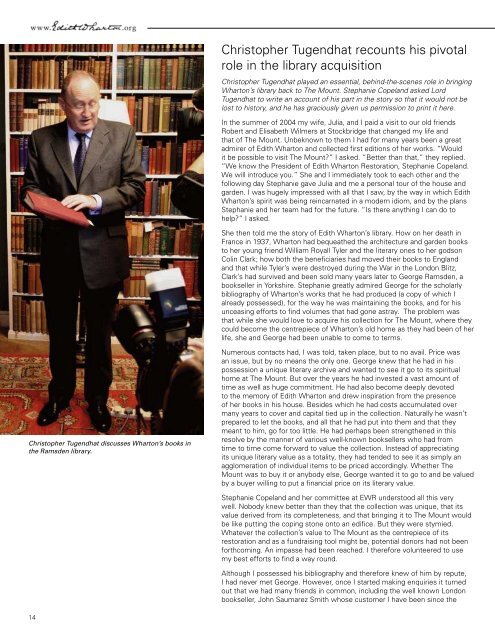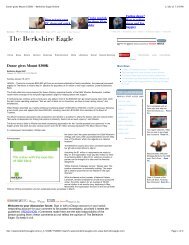Annual News&Financial Report - The Mount
Annual News&Financial Report - The Mount
Annual News&Financial Report - The Mount
You also want an ePaper? Increase the reach of your titles
YUMPU automatically turns print PDFs into web optimized ePapers that Google loves.
Christopher Tugendhat discusses Wharton’s books in<br />
the Ramsden library.<br />
Christopher Tugendhat recounts his pivotal<br />
role in the library acquisition<br />
Christopher Tugendhat played an essential, behind-the-scenes role in bringing<br />
Wharton’s library back to <strong>The</strong> <strong>Mount</strong>. Stephanie Copeland asked Lord<br />
Tugendhat to write an account of his part in the story so that it would not be<br />
lost to history, and he has graciously given us permission to print it here.<br />
In the summer of 004 my wife, Julia, and I paid a visit to our old friends<br />
Robert and Elisabeth Wilmers at Stockbridge that changed my life and<br />
that of <strong>The</strong> <strong>Mount</strong>. Unbeknown to them I had for many years been a great<br />
admirer of Edith Wharton and collected first editions of her works. “Would<br />
it be possible to visit <strong>The</strong> <strong>Mount</strong>?” I asked. “Better than that,” they replied.<br />
“We know the President of Edith Wharton Restoration, Stephanie Copeland.<br />
We will introduce you.” She and I immediately took to each other and the<br />
following day Stephanie gave Julia and me a personal tour of the house and<br />
garden. I was hugely impressed with all that I saw, by the way in which Edith<br />
Wharton’s spirit was being reincarnated in a modern idiom, and by the plans<br />
Stephanie and her team had for the future. “Is there anything I can do to<br />
help?” I asked.<br />
She then told me the story of Edith Wharton’s library. How on her death in<br />
France in 19 7, Wharton had bequeathed the architecture and garden books<br />
to her young friend William Royall Tyler and the literary ones to her godson<br />
Colin Clark; how both the beneficiaries had moved their books to England<br />
and that while Tyler’s were destroyed during the War in the London Blitz,<br />
Clark’s had survived and been sold many years later to George Ramsden, a<br />
bookseller in Yorkshire. Stephanie greatly admired George for the scholarly<br />
bibliography of Wharton’s works that he had produced (a copy of which I<br />
already possessed), for the way he was maintaining the books, and for his<br />
unceasing efforts to find volumes that had gone astray. <strong>The</strong> problem was<br />
that while she would love to acquire his collection for <strong>The</strong> <strong>Mount</strong>, where they<br />
could become the centrepiece of Wharton’s old home as they had been of her<br />
life, she and George had been unable to come to terms.<br />
Numerous contacts had, I was told, taken place, but to no avail. Price was<br />
an issue, but by no means the only one. George knew that he had in his<br />
possession a unique literary archive and wanted to see it go to its spiritual<br />
home at <strong>The</strong> <strong>Mount</strong>. But over the years he had invested a vast amount of<br />
time as well as huge commitment. He had also become deeply devoted<br />
to the memory of Edith Wharton and drew inspiration from the presence<br />
of her books in his house. Besides which he had costs accumulated over<br />
many years to cover and capital tied up in the collection. Naturally he wasn’t<br />
prepared to let the books, and all that he had put into them and that they<br />
meant to him, go for too little. He had perhaps been strengthened in this<br />
resolve by the manner of various well-known booksellers who had from<br />
time to time come forward to value the collection. Instead of appreciating<br />
its unique literary value as a totality, they had tended to see it as simply an<br />
agglomeration of individual items to be priced accordingly. Whether <strong>The</strong><br />
<strong>Mount</strong> was to buy it or anybody else, George wanted it to go to and be valued<br />
by a buyer willing to put a financial price on its literary value.<br />
Stephanie Copeland and her committee at EWR understood all this very<br />
well. Nobody knew better than they that the collection was unique, that its<br />
value derived from its completeness, and that bringing it to <strong>The</strong> <strong>Mount</strong> would<br />
be like putting the coping stone onto an edifice. But they were stymied.<br />
Whatever the collection’s value to <strong>The</strong> <strong>Mount</strong> as the centrepiece of its<br />
restoration and as a fundraising tool might be, potential donors had not been<br />
forthcoming. An impasse had been reached. I therefore volunteered to use<br />
my best efforts to find a way round.<br />
Although I possessed his bibliography and therefore knew of him by repute,<br />
I had never met George. However, once I started making enquiries it turned<br />
out that we had many friends in common, including the well known London<br />
bookseller, John Saumarez Smith whose customer I have been since the<br />
1960s and for whom he had once worked. I also learned that he was<br />
the son of Sir James Ramsden with whom I had been a colleague<br />
some 0 years previously when we were both Members of the British<br />
House of Commons. So it was with hope as well as trepidation that<br />
one cold February day in 005 I took the train from London to York.<br />
George met me at the station and drove me to his old stone rectory in<br />
the village of Settrington near Malton. Except that we were in England<br />
rather than New England, the weather was such that at any moment<br />
I might have expected to see Ethan Frome come looming out of the<br />
snow-covered countryside.<br />
When we arrived George showed me to the upstairs room given<br />
over to the Wharton books and left me alone with them. It was a<br />
most astonishing experience. <strong>The</strong> completeness of the collection and<br />
the way he had arranged it provided a window into her mind as well<br />
as an understanding of the influences that had formed her. It was<br />
almost as if she had been brought to life. And not just her. Through<br />
the inscriptions in the books they had exchanged, her friends and<br />
contemporaries, such as Henry James, Henry Adams, and <strong>The</strong>odore<br />
Roosevelt, were also in the room, as well as her rather nefarious<br />
lover, Morton Fullerton, thanks to the book he had written and<br />
dedicated to her.<br />
When after communing for some time with these ghosts I was called<br />
to the delicious lunch prepared by Jane Ramsden, the three of us<br />
had plenty to talk about. Mostly we discussed the books and Edith<br />
Wharton. But in due course George and I turned to money and terms,<br />
with me making clear that I was not an emissary of <strong>The</strong> <strong>Mount</strong> so<br />
much as a facilitator trying to bring the two sides back into contact<br />
with each other. In that I was successful, but a gap remained. It was<br />
as if George on the one side and Stephanie and her board on the<br />
other were reaching out to each other across it with arms extended<br />
but still unable to touch hands.<br />
It was a few months after this that Robert Wilmers re-entered the<br />
scene with a crucial intervention. He had kept in touch with what was<br />
going on and decided that decisive action was required. Would a deal<br />
be possible, he asked, if the financial means were forthcoming, or<br />
were there other factors in the way? I told Stephanie I was sure a deal<br />
was attainable since I believed we had won George’s confidence on<br />
all the non-financial issues. With the backing of Robert and Elisabeth a<br />
revised proposition was then produced, designed to enable the hands<br />
not just to touch but to shake. So again I took the train to York, again<br />
I was let loose among the books and again Jane prepared a delicious<br />
lunch. This time though the denouement was very different. When I<br />
told George what <strong>The</strong> <strong>Mount</strong> had in mind, he immediately indicated<br />
that so long as the lawyers and accountants were happy a deal would<br />
be forthcoming. And so it was.<br />
Thus it was that in December 005, shortly before Christmas, I<br />
made my third trip to Settrington. This time I was accompanied by<br />
Stephanie and the London correspondent for <strong>The</strong> New York Times,<br />
Alan Cowell. People from <strong>The</strong> <strong>Mount</strong> were already at George’s house<br />
to help with the packing up of the books, the deal was ceremoniously<br />
signed and cameras and videos recorded the event. Another delicious<br />
lunch was eaten and champagne was drunk. Shortly afterwards the<br />
Edith Wharton library crossed the Atlantic followed in due course by<br />
George to see the books into their new home and to arrange them to<br />
the best effect.<br />
Finally on a showery spring day in April 006, less than two<br />
years after Robert and Elisabeth had hosted that fateful lunch at<br />
Stockbridge, the last act in this literary drama was played out. <strong>The</strong><br />
First Lady of the United States came to <strong>The</strong> <strong>Mount</strong> to welcome back<br />
to her own country the library of the First Lady of American Letters.<br />
Jane Ramsden (2nd from left) offers a toast to the absent<br />
benefactors after the signing.<br />
George Ramsden (right) explains <strong>The</strong> <strong>Mount</strong>’s library layout to<br />
Robert Wilmers (center), Elisabeth Wilmers, and Lord Tugendhat.<br />
14 15



